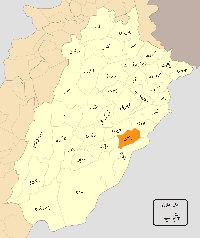Pakpattan District
| ضِلع پاکپتّن | |
|---|---|
| District | |
| Pakpattan District | |
 Location of Pakpattan in Punjab. | |
| Country | Pakistan |
| Province | Punjab |
| Headquarters | Pakpattan |
| Government | |
| • D.C.O | District Co-ordination Officer Under Provincial Government |
| Population (1998) | |
| • Total | 1,286,680 |
| Time zone | PST GMT +5:00 Islamabad, Karachi |
| Number of Tehsils | 2 |
Pakpattan District (Urdu: ضِلع پاکپتّن), is a district of Punjab Province in Pakistan, Pakpattan is the district capital. According to the 1998 census of Pakistan, it had a population of 1,286,680 of which 14% were urban.[1] It has since risen to 1,563,000.[2]
Administration
The district is divided into two tehsils, which contain a total of 63 Union Councils:[3]
| Tehsil | No. of Unions |
|---|---|
| Arifwala Tehsil | 26 |
| Pakpattan Tehsil | 28 |
Pakpattan is the city of the great Saint Baba Farid of Chisti. The original name of Pakpattan was "Ajodhan". It was renamed Pakpattan after it was used for the first time by Saint Hazrat Baba Fariduddin Ganj Shakar. The word Pakpattan consists of two words "pak" and "pattan" meaning "clean dockland" (Pattan means a dockland or place where ships or boats stop). The city was given this name by Saint Baba Farid. It is said, once Saint Farid having ablution on the bank of the River Sutlej. One local man told the Saint that this water is unclean and place is dirty then Saint Farid replied to him "no its clean water and place' in the local language "Pak Pattan'.However,King Akbar declared the Name Pakpattan.
Location
The capital Pakpattan is located about 207 km from Lahore and 205 km from Multan. The district is bounded to the northwest by Sahiwal District, to the north by Okara District, to the southeast by the Sutlej River and Bahawalnagar District, and to the southwest by Vehari District.
History
Pakpattan District was agricultural region with forests during the Indus Valley Civilization. The Vedic period is characterized by Indo-Aryan culture that invaded from Central Asia and settled in Punjab region. The Kambojas, Daradas, Kaikayas, Madras, Pauravas, Yaudheyas, Malavas and Kurus invaded, settled and ruled ancient Punjab region. After overrunning the Achaemenid Empire in 331 BCE, Alexander marched into present-day Punjab region with an army of 50,000. The Pakpattan was ruled by Maurya Empire, Indo-Greek kingdom, Kushan Empire, Gupta Empire, White Huns, Kushano-Hephthalites and Shahi kingdoms.
In 997 CE, Sultan Mahmud Ghaznavi, took over the Ghaznavid dynasty empire established by his father, Sultan Sebuktegin, In 1005 A.D. he conquered the Shahis in Kabul in 1005, and followed it by the conquests of Punjab region. The Delhi Sultanate and later Mughal Empire ruled the region. The Punjab region became predominantly Muslim due to missionary Sufi saints whose dargahs dot the landscape of Punjab region.
After the decline of the Mughal Empire, the Sikh conquered Pakpattan District. During the period of British rule, Pakpattan district increased in population and importance.
The predominantly Muslim population supported Muslim League and Pakistan Movement. After the independence of Pakistan in 1947, the minority Hindus and Sikhs migrated to India while the Muslim refugees from India settled in the Pakpattan District. The main reason of famicity of this city is due to Hazzrat Baba Farid(Rehmullah). Basically he is the man who renamed Ajodhan Pakpattan. Before his arrival to Pakpattan, there were at least 30,000 Hindus and Sikhs in Pakpattan. He came to Pakpattan on the orders of his murshad Hazrat Qutbuddin Bakhtiar Kaki (Rehmullah) for preaching of Islam.
On July 6, 1910, First Rail Link was established of Pakpattan. 345.7 km (213.4 mi) long Lodhran - Kasur section was opened. This section was later dismantled during World War I, reconstructed and opened again between 1923 and 1924. On April 15, 2002 a new Karachi to Lahore express via Pakpattan was introduced. The name of the train is Fareed Express.[4]
Language
Punjabi is the native spoken language[5] but Urdu is also widely understood. Haryanvi also called Rangari is spoken among Ranghar, Rajputs. The Meo Rajputs have their own language which is called Mewati.
Agriculture
The Pakpattan District is known for the fertility of its soil and most of the population of Pakpattan district makes a living on agriculture. The main crops are wheat, rice, cotton, maize (corn), sugar cane, etc. The primary fruits and vegetables that are harvested are mango, guava, carrots, potatoes, oranges and okra.
Malka Hans
Malka Hans is the ancient famous town near Pakpattan in Pakpattan District located between Pakpattan and Sahiwal on Pakpattan Sahiwal Road. It is famous for origin of great book (Heer Waris Shah) written by poet Waris Shah.
References
External links
Coordinates: 30°18′N 73°16′E / 30.300°N 73.267°E
_Districts.svg.png)